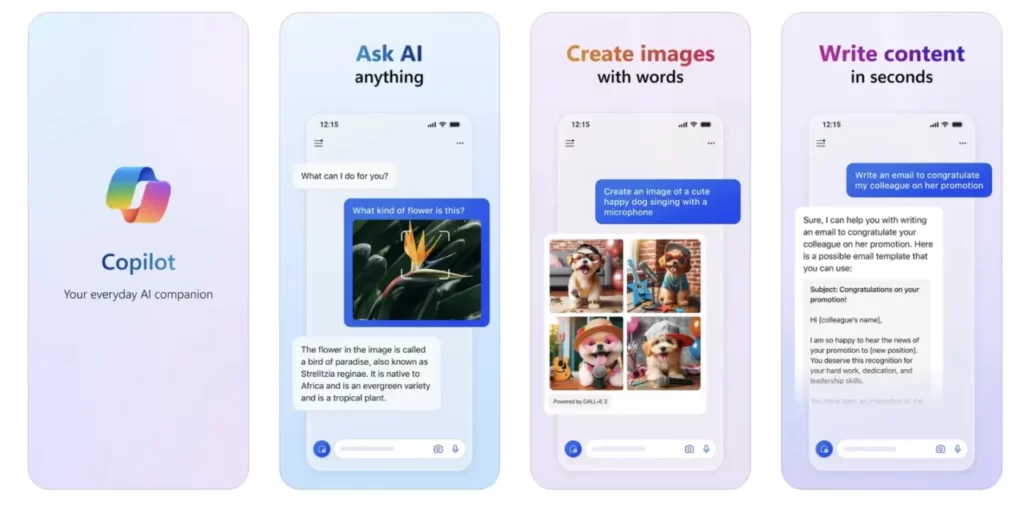Microsoft has expanded the reach of its AI-powered chatbot, Copilot, by launching the app on iOS, iPadOS, and macOS. The release brings Copilot to a wider audience by releasing just after the release of the Android version. This move aligns with Microsoft’s strategy to provide a standalone experience akin to OpenAI’s ChatGPT.
Key Features
Some of the key features of Copilot are:
- Code suggestions: Copilot can suggest code for a wide range of programming languages and frameworks, such as Python, JavaScript, React, Ruby, Java, C#, and more. Copilot can also handle common tasks such as parsing data, testing, formatting, and documentation.
- Code generation: Copilot can generate code from natural language descriptions, comments, or examples. For instance, the developer can write “create a function that reverses a string” and Copilot will generate the corresponding code.
- Code completion: Copilot can complete the code that the developer has started writing, filling in the missing parts or correcting the errors. Copilot can also offer multiple alternatives for the same code, allowing the developer to choose the best one.
- Code adaptation: Copilot can adapt the code to different scenarios, such as changing the input/output format, adding or removing parameters, or modifying the logic. Copilot can also refactor the code to make it more readable, concise, or efficient.
Versatility in Functionality

Copilot is not limited to a specific domain or use case. It can help developers with any kind of coding project, from web development to data science to game development. Copilot can also handle different levels of complexity, from simple scripts to complex applications. Copilot can also work with different types of data, such as text, images, audio, or video.
Copilot is also not limited to a specific editor or environment. It can work with any code editor that supports the Language Server Protocol (LSP), such as Visual Studio Code, Atom, Sublime Text, or Vim. Copilot can also work with any cloud platform or service that supports the Copilot API, such as GitHub, Azure, AWS, or Google Cloud.
Beyond typical chatbot interactions, Copilot stands out by integrating with the text-to-image generator DALL-E3. This integration enables users to create images seamlessly within the app. The versatility of Copilot extends to tasks such as drafting emails and summarizing text, enhancing its utility for a diverse range of users.
Rebranding for a Standalone Experience
Microsoft’s decision to rebrand Bing Chat as Copilot signifies a strategic shift toward offering a standalone experience, mirroring the trajectory of ChatGPT. This rebranding effort is not limited to mobile apps; Microsoft has also introduced a dedicated web experience for Copilot, distinct from Bing.
Access to GPT-4
One notable advantage of using Copilot is the access it provides to GPT-4, OpenAI’s latest language model. This positions Copilot as a compelling choice for users seeking the enhanced capabilities offered by GPT-4 without the need for a subscription. In contrast, the free version of ChatGPT utilizes the preceding GPT-3.5 model.
Seamless User Experience
Copilot is designed to provide a seamless and intuitive user experience for developers. Copilot can be easily installed and activated on any iOS device, such as iPhone or iPad. Copilot can also sync with the user’s account and preferences across different devices and platforms, such as Windows, Mac, Linux, or Android. Copilot can also work offline, using the device’s local storage and processing power.
Copilot also has a user-friendly and customizable interface, allowing the user to adjust the settings and preferences according to their needs and preferences. Copilot also has a smart and interactive feedback system, allowing the user to rate, review, and improve the suggestions and generations from Copilot. Copilot also has a robust and secure privacy and security system, ensuring that the user’s data and code are protected and encrypted.
Cross-Platform Availability
Copilot is not only available for iOS users but also for other platforms and devices. Copilot can be accessed through the following ways:
- Copilot app: The Copilot app is the main way to access Copilot on mobile devices, such as iOS or Android. The Copilot app allows the user to create, edit, run, and share code on their device, using Copilot’s suggestions and generations. The Copilot app also allows the user to connect and collaborate with other developers, using Copilot’s features and functions.
- Copilot extension: The Copilot extension is the original way to access Copilot on desktop devices, such as Windows, Mac, or Linux. The Copilot extension allows the user to integrate Copilot with their preferred code editor, such as Visual Studio Code, Atom, Sublime Text, or Vim. The Copilot extension also allows the user to access Copilot’s features and functions within their editor, using Copilot’s suggestions and generations.
- Copilot web: The Copilot web is the alternative way to access Copilot on any device, using a web browser. The Copilot web allows the user to use Copilot’s features and functions without installing or activating anything, using Copilot’s suggestions and generations. The Copilot web also allows the user to save and share their code online, using Copilot’s cloud storage and service.



